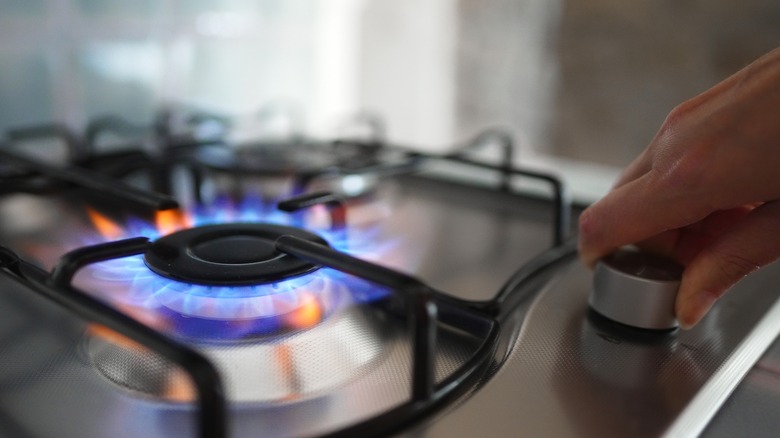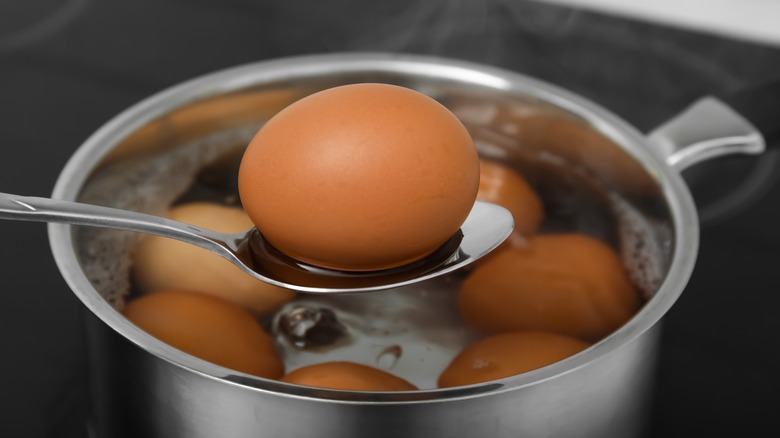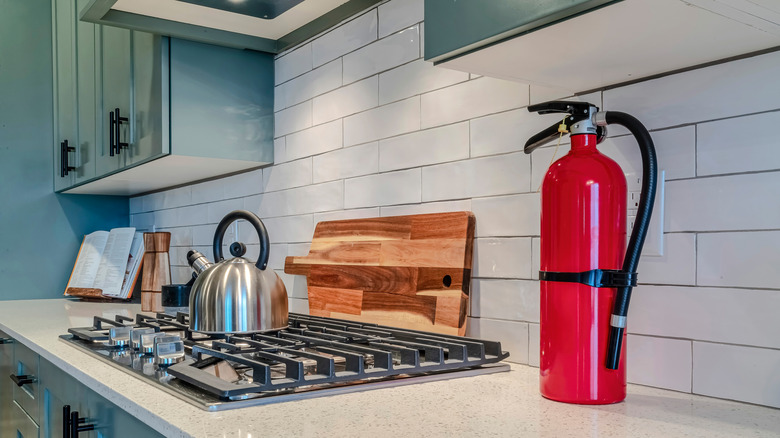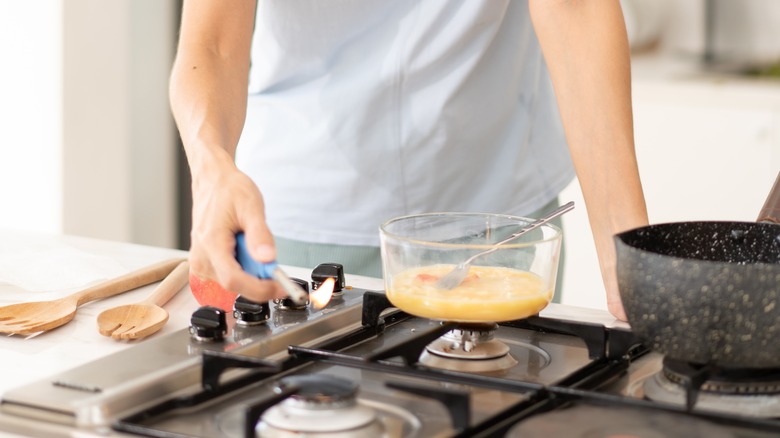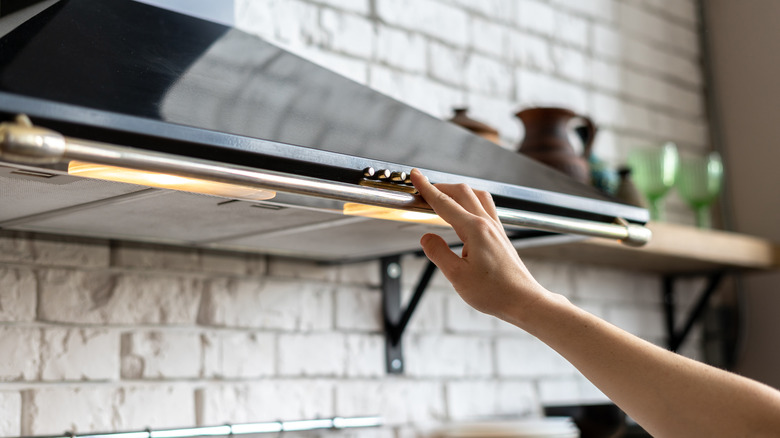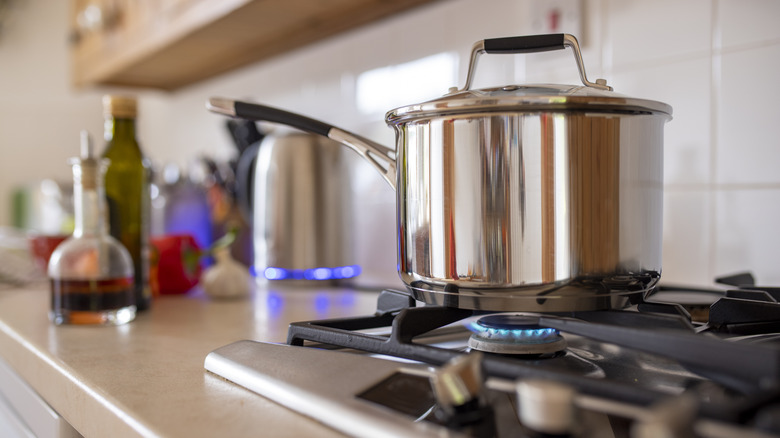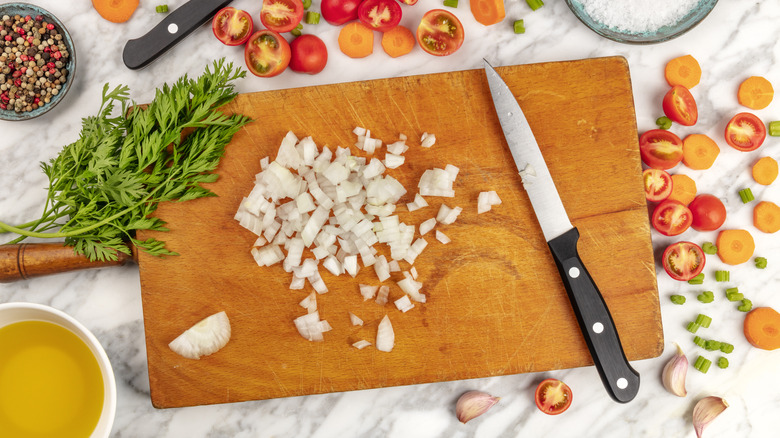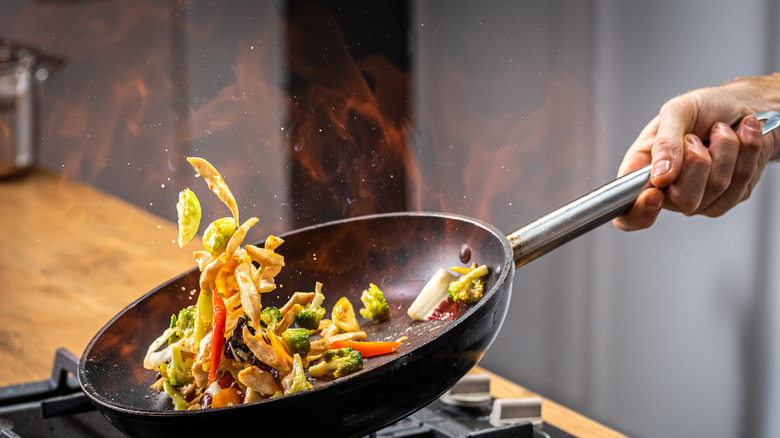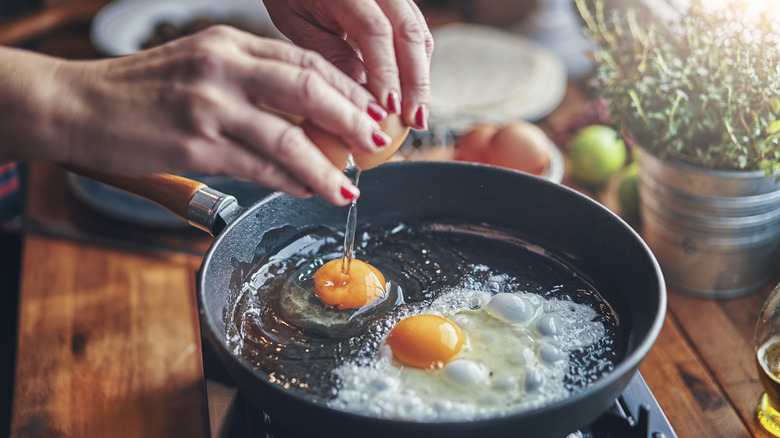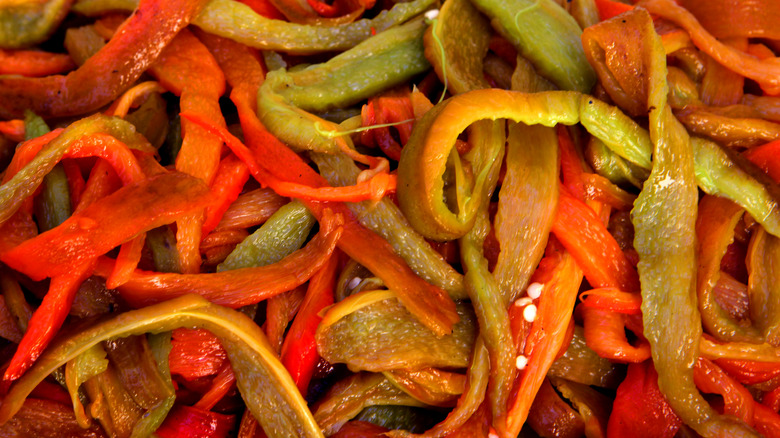10 Tips You Need When Cooking On A Gas Stovetop
Are you thinking about making the switch to a gas stove? Or have you already boarded the butane train? Chances are, if you live in California, Nevada, Illinois, New York, or New Jersey, you're familiar with gas cooking. While most other states still favor electric, gas stoves have nevertheless found a following. Proponents even claim they make food taste better, although that myth deserves to be busted.
Unlike coal or wood, the flame from a gas stove doesn't impart any flavor. However, gas stoves are more responsive to temperature adjustments than coils, which take time to heat up and cool down. Gas stoves adjust the amount of gas being released, causing the size of the stovetop flame to increase or decrease in real-time. This is more energy-efficient than the standard electric stove, and it's also easier to control the heat.
Still, there are concerns about the potential health risks of using gas stoves. They produce nitrogen dioxide, exposure which has been linked to respiratory issues. Gas leaks, too, are problematic for the environment as well as for human health. Like a mandoline slicer, a gas stove can be slightly scary if you don't know what you're doing — but it can also be the secret weapon in your culinary arsenal. Here are the tips you should know before cooking on a gas stovetop.
1. Get to know your gas stove's heat
Gas stoves heat up faster than electric stoves because they produce a direct flame under your pots and pans. So when a recipe calls for turning your burner to medium or high heat, the knob might not be the most accurate indicator for your gas stovetop. While it's convenient to be able to adjust your cooking temperature on the fly, that also means gas stoves are less forgiving if you bump the heat too high by accident. The good news is it's easy to slow the flame down if you notice your food going from toasty to charred — as long as you're paying attention.
The first few times you use your gas stove, keep a close eye on where the knob is placed when your pot comes to a simmer and a rolling boil. When you use different pans and utensils, notice the temperature when the fat starts to sizzle and when you get a good sear. For stainless steel and cast iron pans, for example, you might need lower temperatures than for nonstick cookware. A perk of this process is that cooking on gas can make you a more intuitive home chef. By carefully gauging the flame and using all your senses, you're never left guessing how hot the stove actually is or how your food will turn out.
2. Learn to sniff out the smell of gas
Every time you turn on your burner and ignite your stove, you'll likely notice an unpleasant smell, akin to rotten eggs. Gas companies add chemicals that give off this odor to ensure gas stove users can quickly identify a potential leak. Gas leaks can be deadly if the hazardous pollutants build up to unsafe levels, causing carbon monoxide poisoning. Although these chemicals are no longer harmful once the gas is burned, most gas stoves still have minor leaks.
Recognizing the smell of gas and how to turn off the main source is essential for safely using a gas stove. If you continue to notice the smell of gas when you're cooking, apart from the few seconds when you turn on the burner), it's time to get a maintenance check on your stove (which should be done annually anyway). And if there's a strong smell of gas in your kitchen, it's best to get out of your residence immediately and call your gas provider.
The smell of gas might not be noticeable for some people, especially if you've become accustomed to cooking with gas. Installing a natural gas detector with an alarm — and getting it serviced regularly — is a safer option.
3. Keep a fire extinguisher handy
Cooking over an open flame naturally means there's an increased fire risk. As with any type of stove, it's important to take sensible precautions while cooking. Don't keep kitchen towels, aprons, or paper towels around the stove. Avoid leaving wooden utensils nearby either, always roll up your sleeves, and turn pot handles toward the back of the stove.
While these tips apply to kitchen safety in general, special precautions are needed for gas stoves. Gas fires are categorized as Class B, which means you should never try to put them out with water. The fire burns so hot that it turns water into steam, increasing your chances of sustaining a nasty burn. While Class B fires aren't common, they can be the most deadly.
A Class B extinguisher will put out a gas fire (electric stoves require Class C extinguishers, so if you're making the switch, upgrade your fire extinguisher, too.) Once the fire is under control and you're out of danger, switch off the gas main. Get a maintenance check before you use the stove again, as a fire could have damaged the burners.
As a rule, turn off the gas main once you're done cooking, being especially vigilant before you leave the house or go to bed. Fortunately, gas fires are immediately visible, unlike an electrical element that remains hot for some time causing potential damage. Once you turn the knob off, a gas burner isn't hot enough to ignite a fire.
4. Light up responsibly
Never, ever leave gas running. While this might sound obvious due to the fire risk, there's another reason to ignite the gas as soon as you turn it on. Breathing in the pollutants from unburned gas can increase your risk of lung cancer and respiratory diseases. Once the gas is lit, however, it's harmless.
Don't keep fruitlessly clicking away with your manual ignition lighter while gas builds up in the air. If it takes more than a few seconds to light your stove, turn it off and allow your kitchen to air out for a couple of minutes before trying again. In case you have a built-in ignition that refuses to light up the stove, turn the power off and check the wires for any damage.
Sometimes, the ignition lighter isn't the issue. Food particles or water around your burner could be preventing the gas from coming out. In that case, switch off the gas and remove the burner grate. Wipe it clean and dry thoroughly before reassembling. Finally, when you're lighting up, make sure the flame is blue or mostly blue with yellow tips. This indicates that your stove is working correctly, whereas a red or orange flame means it's time for a maintenance check.
5. Don't forget a ventilation hood
Even when you follow every safety precaution while using a gas stove, small leaks can still occur unnoticed. These are responsible for the potential health concerns of gas stoves, including links to asthma and respiratory illness. Studies more conclusively show negative impacts on children than adults, so be particularly mindful of airing out your cooking space if you have kids in the house. Keep them away from the stove while cooking, and turn off the gas mains anytime your stove is not in use.
The culprit here is unburned gas, which contains benzenes and nitrogen dioxide — both compounds that could have negative health effects over time or at high concentrations. You can mitigate these risks by opening the windows while you're cooking and turning on the exhaust fan. A ventilation hood is a must when using a gas stove and should be turned on before you start cooking.
Ventilation hoods can also suck hot air away from your stovetop, so you might have to cook at higher temperatures to get the same results. For minimum effort, get a hood with an auto-cleaning function. You can even get a hood and microwave combination if you're short on space.
6. Remember the burner won't keep your food warm
While you can keep food warm for a little while on an electric burner, a gas stove doesn't offer the same advantage. As soon as you turn off the flame, your pan will start cooling down. It's a small change that can make a significant difference to your cooking if you're switching over from electric. Getting a feel for cooking on your gas stove might not happen overnight, but you can adopt a few helpful habits.
When cooking a grain like rice or quinoa, for example, you'll likely need to simmer it a little longer before covering and allowing it to absorb the water. Be conservative with how much water you add, as gas stoves switch from a boil to a simmer more quickly. On the plus side, you can keep your pot on the same burner without worrying the bottom will burn. Cover your pots and pans before turning them off to trap as much heat as possible. You can leave food in the oven at a low temperature to keep it warm, but it will dry out proteins and overcook vegetables if you leave them for too long.
7. Keep your ingredients ready to go
Cooking with gas? A mise en place is your friend. This French term comes from the restaurant industry, where chefs prepare ingredients and recipe components at different workstations. This ensures dishes come together smoothly, with nothing missed. The result? A standard of efficiency and consistency that you can apply to your home kitchen and gas stove, albeit at a smaller scale.
Gas stoves change temperature as soon as you turn the knob. That means you can expect your pan to start heating up or cooling down right away, as opposed to electric stoves, which take a little time to adjust. While it's always a good idea to have your ingredients prepped, combine this practice with a gas stove and watch your cooking times reduce.
To prepare your mise en place, first read the recipe through, checking that you have all the ingredients or substitutions on hand. Get them out of your cabinets and measure the correct quantities, if needed; seasonings are usually a matter of the heart while baking ingredients should be precise. Then move on to your basic prep: chopping vegetables, blending sauces, toasting spices, and marinating proteins.
If you weren't already practicing mise en place before, an added incentive is knowing that the process can give you a mental boost before cooking. Instead of a chaos-fueled "Kitchen Nightmare" scenario, your kitchen could be run as tightly as a pro chef's.
8. Get the most out of your wok
Chinese restaurant kitchens often have a special wok burner, designed to create the searingly hot conditions required for a good stir-fry. The characteristic wok hei flavor of takeout Chinese, or Thai noodle dishes, comes from a mist of oil that hits the flame. The vigorous motion of the wok then catches the oil droplets, infusing the food with a rich smokiness.
You might not be able to achieve wok hei at home on a regular stovetop, but there are other benefits to cooking in a wok. High heat and quick cooking preserves the crunch of vegetables and the juiciness of meat, leading to a superior stir-fry. If your stir-fries turn out sad and soggy, it's likely your wok isn't hot enough.
While you can use a flat-bottom wok on an electric stovetop, a gas burner allows you to cook in a traditional round-bottom wok. It's easier to stir and toss, so every morsel comes into contact with the pan and your sauce. Crank up the heat without worrying that your food will burn on the bottom, which can be a problem with flat-bottom woks. Since stir-frying is such a fast process, being able to control the heat with a touch is vital.
Deep-frying, too, isn't as arduous with a round-bottom wok. You need less oil to fill the base of the wok compared with a flat pan, and scooping out food once it's golden brown is a breeze.
9. Join the cult of the cast iron pan
Cast iron pans aren't always the best choice for glass top stoves, due to their heavy weight and textured surface. If you're not careful, it's possible to crack the glass. Luckily, they work a treat on gas stoves. The adaptability of gas temperature means you can preheat a cast iron over a medium flame, ensuring no cold or uneven spots.
Cast iron pans can warp if they're heated too rapidly, so it's important to keep the flame low to start. Once it's warm, turn the heat up to saute or fry your food, turning out a variety of recipes in your cast iron skillet. When cooking with cast iron, precise heat control is your best friend.
A cast iron skillet is convenient for braising and searing, as it can go directly from the stovetop to the oven. This makes it great for baking, too. The greatest danger of acquiring a cast iron skillet is becoming obsessed with it. When you find yourself describing the seasoning process in excruciating detail to everyone you encounter, it's time to draw the line.
10. Char vegetables over a gas stove's flame
Since you're working with an open flame, why not bring the campfire experience into your kitchen? With a good metal grill rack and a trusty pair of tongs, take your culinary expertise to a new level by charring, roasting, and grilling directly over the fire. If you enjoy the rich flavor of canned fire-roasted tomatoes, you can make them at home. Set a grill pan brushed lightly with oil over your gas flame and place whole tomatoes on top. Add some whole onions and garlic bulbs, and you're on your way to a terrific pasta sauce or a complex base for chili.
Alternatively, grip the tomatoes with tongs and stick them straight into the fire for easier turning — it only takes a few minutes to get their skins bubbling. This method can be used for any large vegetables that are easy to hold, like eggplants, bell peppers, and corn on the cob.
Spice up your next taco Tuesday with a charred tomato salsa. Convert eggplant haters by mashing creamy roasted eggplant into a smoky Indian bharta or Levantine babaganoush. Or you can char red bell peppers until the skins blacken, then put them in a jar while still warm. The steam helps the skins slip off, and the chopped peeled peppers can be marinated in olive oil and garlic for a delicious antipasto.
